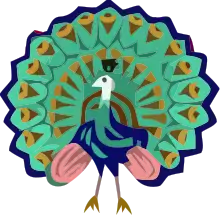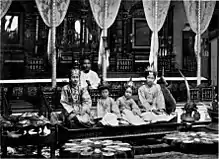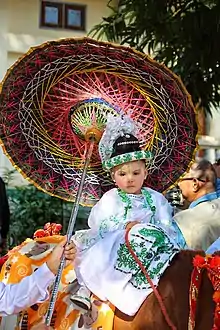Twelve Auspicious Rites
The Twelve Auspicious Rites (Burmese: လောကီမင်္ဂလာဆယ့်နှစ်ပါး, လောကီမင်္ဂလာဆယ့်နှစ်ခန်း, and လောကီမင်္ဂလာဆယ့်နှစ်ဖြာ) are a series of worldly rites of passage recognized in traditional Burmese culture, particularly by the Bamar.[1][2] These are distinct from the Thirty-eight Buddhist Beatitudes described in the Maṅgala Sutta.[3]
| Part of a series on the |
| Culture of Myanmar |
|---|
 |
| People |

In modern times, only four or five of these rites — the naming, first feeding, ear-boring, shinbyu, and wedding rites — are commonly practiced in Myanmar, especially in urban cities.[4] In pre-colonial Burma, Brahmins typically consecrated or led these rites.[4] Today, masters of ceremony who specialize in abhisheka rituals, called beiktheik saya (ဘိသိက်ဆရာ), consecrate these rites.[3]
List of rites

- Vijāta Maṅgalā (ဝိဇာတမင်္ဂလာ) – the successful delivery of a child[2][1]
- Mukhadassana Maṅgalā (မုခဒဿနမင်္ဂလာ) – the taking of refuge in the Three Jewels, worship of the Nandimukha nat, and paying of obeisance to a child's grandparents on the third day of a child's birth[1][Note 1]
- Kesacchedana Maṅgalā (ကေသစ္ဆေဒနမင်္ဂလာ) – the shaving of a child's hair on the 7th day of a child's birth[2][1]
- Dolākaraṇa Maṅgalā (ဒေါလာကရဏမင်္ဂလာ) – the first cradling of a child on an auspicious day[2][1][Note 2]
- Tambūlabhatta Maṅgalā (တမ္ဗူလဘတ္တမင်္ဂလာ) – the first ceremonial feeding of betel nut (flavored with catechu, licorice, and fennel seeds) to a child, on the 75th or 100th day of a child's birth[4][1][Note 3]
- Ravindudassana Maṅgalā (ရဝိန္ဒုဒဿနမင်္ဂလာ) – the first revealing of a child to the sun and moon on the full moon day of the first, second, or third Burmese lunar months following a child's birth[4][1]
- Nāmakaraṇa Maṅgalā (နာမကရဏမင်္ဂလာ) – the naming of a child based on a child's personalized horoscope (ဇာတာ) on the 100th day of a child's birth[2][1]
- Bhattāhāra Maṅgalā (ဘတ္တာဟာရမင်္ဂလာ) – the first ceremonial feeding of solid food (steamed rice) to a child, also commemorated with the donation of food alms to Buddhist monks, on the 6th month of a child's birth[2][1][Note 4]
- Kesabandhana Maṅgalā (ကေသာဗန္ဓနမင်္ဂလာ) – the hair-knotting of a child, after the hair is shampooed with traditional herbal shampoo made with soap acacia and Grewia elastica on an auspicious day[1]
- Kaṇṇavijjhana Maṅgalā (ကဏ္ဍဝိဇ္ဈနမင်္ဂလာ) – the ear-boring ceremony of a child an auspicious day[2][1]
- Pabbajja Maṅgalā (ပဗ္ဗဇ္ဇမင်္ဂလာ) – shinbyu, the ordination of a child into the Buddhist monkhood as a samanera on an auspicious day[2][1][Note 5]
- Āvāha Maṅgalā (အာဝါဟဝိဝါဟမင်္ဂလာ) – the wedding ceremony on an auspicious day[2][5][1][Note 6]
The scholar Aung Chein also identifies a number of auspicious rites outside of the twelve listed above:
- Bhūmyākaraṇa Maṅgalā (ဘူမျာကရဏမင်္ဂလာ) – the first touching of the ground by a child[6]
- Muttasirā Maṅgalā (မုတ္တသိရာမင်္ဂလာ) – the first parting of the child's hair by his or her mother[6]
- Makuṭabandhana Maṅgalā (မကုဋဗန္ဓနမင်္ဂလာ) – the wearing of the makuṭa crown[6]
- Gehakaraṇa Maṅgalā (ဂေဟကရဏမင်္ဂလာ) – the housewarming ceremony[6]
Notes
- Also called Nandīmukhadassana Maṅgalā (နန္ဒီမုခဒဿနမင်္ဂလာ).
- "Dolā" (ဒေါလာ) is sometimes misspelt doḷā (ဒေါဠာ).
- Also called Tambūlāhāra Maṅgalā (တမ္ဗူလာဟာရမင်္ဂလာ). Now sometimes replaced with Sirodaka Maṅgalā (သိရောဒက), the child's first ceremonial hair-washing as betel nut has fallen out of common use.
- Also called Āhāraparibhoga Maṅgalā (အာဟာရပရိဘောဂမင်္ဂလာ, lit. 'enjoyment of food ceremony') or Paṭhamabhatta Maṅgalā (ပဌမဘတ္တမင်္ဂလာ, lit. 'first cooked rice ceremony').
- Also called Sāmaṇerapabbajja Maṅgalā (သာမဏေရပဗ္ဗဇ္ဇမင်္ဂလာ).
- Typically combined with the Vivāha Maṅgalā (ဝိဝါဟမင်္ဂလာ), the rite wherein the daughter is led to her family home before the wedding.
References
- "လောကီမင်္ဂလာ (၁၂) ပါး". Yangon Style (in Burmese). Retrieved 2021-01-17.
- Spiro, Melford E. (1982-05-27). Buddhism and Society: A Great Tradition and Its Burmese Vicissitudes. University of California Press. ISBN 978-0-520-04672-6.
- Houtman, Gustaaf (1999). Mental Culture in Burmese Crisis Politics: Aung San Suu Kyi and the National League for Democracy. ILCAA. ISBN 978-4-87297-748-6.
- "မြန်မာတွင် လောကီမင်္ဂလာလေးမျိုးသာပြုလုပ်တော့ဟု ဗြိတိန်မနုဿဗေဒပညာရှင်ဆို". 7Day News - ၇ ရက်နေ့စဉ် သတင်း. Retrieved 2021-01-17.
- "အစဉ်အလာတွေထဲက မင်္ဂလာဆောင်အခမ်းအနား". The Myanmar Times (in Burmese). 2017-09-29. Retrieved 2021-01-17.
- သခင်အောင်ချိန် (1978). ဆရာဖြစ်သင်ဘိသိက်မင်္ဂလာကျမ်း (in Burmese). ပညာအလင်း.